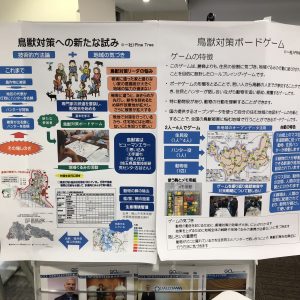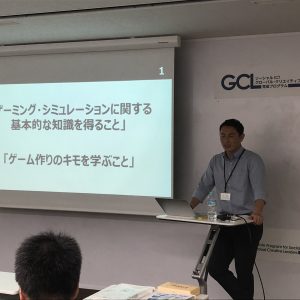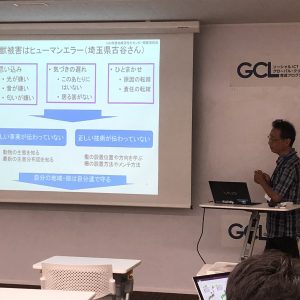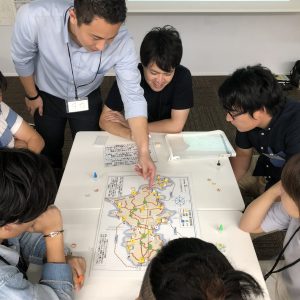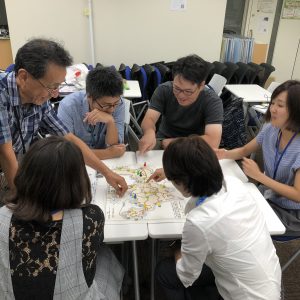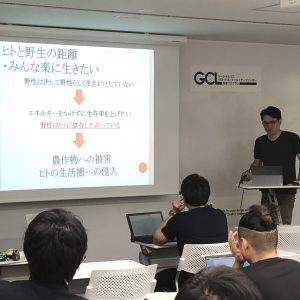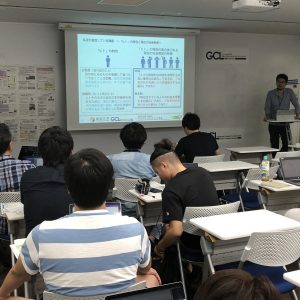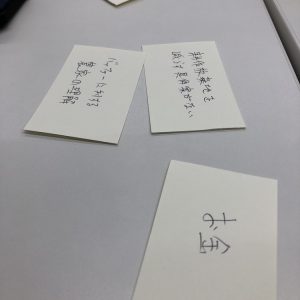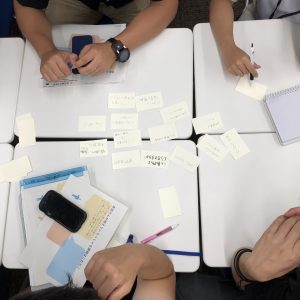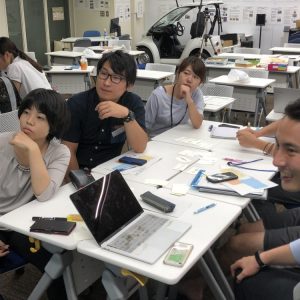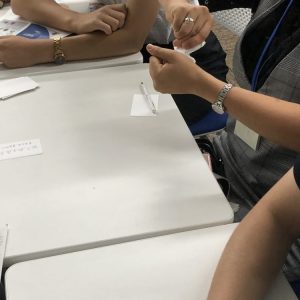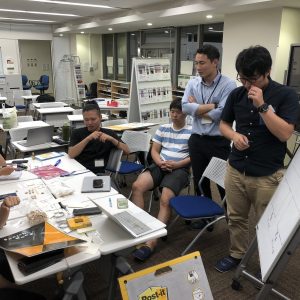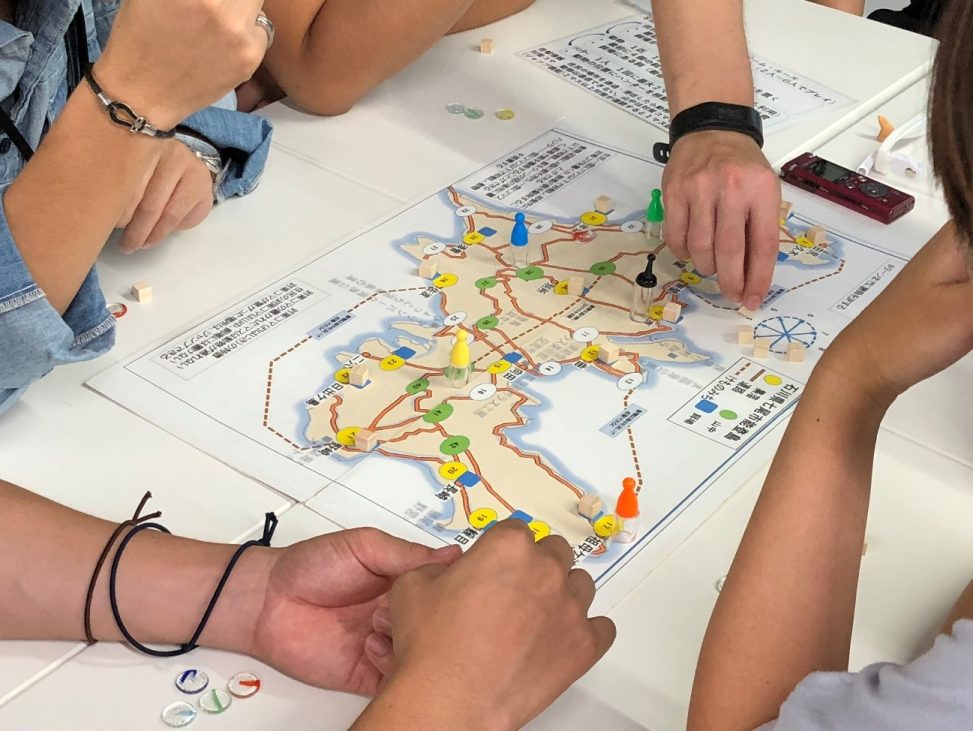
Board Games Are Not Just for Playing, but for Education, Too
Historically, in rural farming and fishing areas of Japan, “territorial disputes” with wild animals have occurred. As the number of local residents decreases, the territory occupied by wildlife continues to expand, and occasionally they are noticeably invading areas where people live. In contemporary Japan, where regional revitalization is a keyword, when considering the promotion of agricultural and mountainous fishing villages, there is a need to think about how to achieve symbiosis between humans and wild animals. While solving such problems requires expert knowledge, there is also a need to involve people who do not have such expertise. Therefore, in this workshop, “gaming/gamification” makes it possible to use a familiar form to present the core of the problem in real social tasks and solutions to people who do not have expert knowledge. The intended outcome of the workshop was to “create a game that considers the symbiosis between humans and wildlife,” and aimed for participants to master skills to discuss social issues and the essence of their solutions during the course of game-making and thinking.
The workshop was divided into several stages. The first stage was a lecture by four specialists. The participants learned the foundations of making an educational game from a specialist with games on the market including ‘Pandemic,’ a game which requires close cooperation from players. They also learned about symbiosis between humans and wildlife from two specialists from Pine Tree, a general incorporated association that produces educational/serious games. After that, participants heard lectures on Local Vitalization Cooperators from Hida City and the Hokkaido Onuma region. They are active in their own field and explained some of the problems in their regions to participants. As a next step, participants learned the process of making games by hearing about the details and production process of games produced based on the countermeasures used against wildlife damage in Noto. Participants also played the game, after which they discussed what kind of game could be made in response to the situations in Hida City and Onuma. At this workshop, Osaka University and Rakuten Co., Ltd. participated, creating opportunities to think about the actual problem-solving in the field through discussions with many different sectors across the framework of GCL.
企画の背景
日本の農山漁村部においては、歴史的に野生動物との“縄張り争い”が行われてきている。しかし、地方居住者の数が減っていく中で、野生動物のテリトリーは拡大を続け、時に人間が居住する区域への侵入もしばしば見られるようになっている。地方創生が一つのキーワードとなっている現代の日本において、農山漁村の振興を考える際には、人間と野生動物との共生をどのように実現するのかを考える必要性が存在する。
一方、このような課題解決においては専門的な知識が必要である一方で、専門的知識を持たない人々を巻き込む必要性がある。そこで、本ワークショップにおいては、現実の社会課題における問題の中核とそのソリューションの提示を、専門的知識を持たない人に対しても親しみやすい形で可能とする「ゲーミング/ ゲーミフィケーション」を行う。ワークショップの最終アウトカムを「人間と野生動物の共生を考えるゲーム」の制作に据え、ゲーム作りの過程において社会課題やその解決策の本質を議論し、考える技術の習得を目指した。
どんなワークショップ?
飛騨市と北海道大沼から現地にて活躍されている地域おこし協力隊の方をお招きし、現場における課題などを紹介して頂いた後に、教育ゲーム/ シリアスゲーム作りを行う一般社団法人Pine Treeの方々から、能登の鳥獣害対策の事例を基に制作されたゲームについて、その詳細と制作過程の共有をして頂き、ゲーム作りのプロセスなどを学んだ。また、鳥獣害対策ゲームのデモプレイを実際に参加者で行い、その効果を体感した上で、飛騨市と大沼から持ち込まれた課題に対して、どのようなゲームを作ることができるのか議論を行った。本ワークショップには、大阪大学、楽天株式会社の方々の参加もあり、GCLの枠を超えて、多くの別セクターの方々との議論を通し、実際の現地における課題解決策を考える機会を創出した。
プログラム
| 1日め | ||
|---|---|---|
| 30min | はじめに:趣旨説明など | |
| 30min | 講演1:松木崇晃氏「教育ゲームの制作プロセスについて」 | |
| 30min | 講演2:今井修氏「能登の鳥獣対策ゲームについて」 | |
| 90min | 講演3:洞翔哉「飛騨市の鳥獣被害対策と獣肉利用推進について」 | |
| 30min | 講演4:吉田浩平「野生動物への餌やり問題」 | |
| 15min | (休憩) | |
| 60min | 発想ワーク:インスピレーション+発想収束ワーク | |
| 15min | まとめ:振り返り | |
| 2日め | ||
| 10min | 導入:二日目のスケジュール共有とウォームアップ | |
| 50min | 共有:前日のワークショップの成果共有など(レビュー&アドオン) | |
| 15min | (休憩) | |
| 45min | 講演5:武田裕之氏「コミュニケーションについて」 | |
| 30min | ゲームデザインワーク1:メッセージの明確化 | |
| 60min | ゲームデザインワーク2ギミックの設計 | |
| 16:30-17:00 | まとめ:発表&全体リフレクション/ラップアップ |
ワークショップの成果
本ワークショップでは、ひな型であるが、野生動物と人間がどのように共生していくべきかをゲーム使用者に考えてもらうボードゲームが完成した。2日間の短めのワークショップではあったが、現場の方による講演と、ゲーム作りの肝要な部分を伝える講演をベースとして、かつゲーム制作の過程を発想→収束→メッセージ化→ギミック設計の4段階に分け、細かいハードルを参加者に与え、それをクリアしていってもらう形にできたことが大きな成果を上げることができた要因だと考える。
ふり返り
GCL GDWS では過去にもカードゲームなどのゲームデザインを主眼としたワークショップがいくつか行われてきており、そういったワークショップにおける蓄積が、今回のワークショップの成果物制作の糧となったのは言うまでもない。GCL GDWS の歴史において、ゲーミフィケーションという近年注目を集めている、アナログなテクノロジーを使用した社会課題解決手法を導入し、それを活用したワークショップを継続的に開催できたことには、大きな意味があると思われる。
また、本ワークショップで作成、起案されたゲームのアイデアは、大沼ラムサール協議会や飛騨市において後に共有され、改善点などを収集した後に、実際のゲーム化のプロジェクトに繋げていく予定である。作成されたゲームを使用した現地におけるワークショップを行うことで、さらにフィードバックを作成し、ゲームデザイン側に返していくプロセス全体の設計をもって、本ワークショップの成果であると言える。ゲームデザインワークショップのノウハウは一般社団法人Pine Treeを介して、蓄積され、他の社会課題に対するゲームデザインに応用される予定である。別種の社会課題に対してゲーミフィケーションを行っていくことで、その解決手法にあるユニバーサルなルールや、個別系統的なボトルネックなどが明らかにされ、ゲーミフィケーションそのものが社会解決課題を探るための一つの手法とすることができれば、一連のGCL GDWSの大きな成果であると考える。
| アイテム | 一般社団法人Pine Tree 制作の鳥獣対策ゲーム、市販のボードゲーム、ブランクカード、サイコロ、小さい木のブロック |
|
|---|---|---|
| 開催日時 | 2018.9.7-8(金- 土)いずれも13:00-17:00 |
|
| 場所 | 東京大学本郷キャンパス GCL ラボ |
|
| 参加者・人数 | 学生8名 |
|
| 講師/ファシリテーター | 吉田浩平(北海道大沼ラムサール協議会事務局) * 本ワークショップは、七飯町役場、飛騨市、北海道大学、大阪大学、北海道国際交流センター(HIF)、一般社団法人Pine Tree の協力の下で行われました。 |
原稿執筆:杉野弘明


